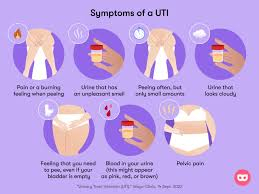



URINARY TRACT INFECTION (UTI)
• UTI may be anatomically subdivided into lower tract infections (urethritis, prostatitis and cystitis) and upper tract infections (pyelonephritis and perinephric abscess).
• UTI is associated with multiplication of organisms in the urinary tract and is defined by the presence of more than 105 organisms/mL in the midstream sample of urine (MSU). This is denoted as "significant bacteriuria". The clinical presentation of UTI may be as follows-
• Asymptomatic bacteriuria- *Presence of bacteriuria (> 105/mL on two occasions in women and on one occasion in men) indicating UTI but without symptoms. *Commonly seen in pregnancy.
• Symptomatic- *Acute urethritis, cystitis. *Acute prostatitis. *Acute pyelonephritis.
*Septicaemia with septic shock.
Aetiology
• Common microorganisms involved in UTis are Escherichia coli (80% cases), Proteus, Klebsiella, Enterobacter, Pseudomonas, Serratia, Chlamydia trachomatis and Neisseria gonorrhoeae (sexually transmitted).
• About one-third of females with dysuria and frequency have either insignificant number of bacteria in midstream cultures or completely sterile cultures. This subset of patients has been defined as having acute urethral syndrome. The syndrome is often due to infection with usual organisms (where culture reveals only 102-104 bacteria) or with unusual organisms (N. gonorrhoeae, Chlamydia trachomatis).
Pathogenesis
• Bacteria gain access to the bladder via the urethra in the vast majority of cases. Ascent of bacteria from the bladder may then follow, which results in parenchymal infections.
• Females are more prone to the development of cystitis due to several reasons-
• Short urethra (4 cm).
• Gram-negative enteric organisms residing near the anal region colonise the periurethral region.
• Absence of bactericidal prostatic secretions.
• Sexual intercourse facilitates entry of introital bacteria into the bladder.
• Susceptibility factor-i.e, the uroepithelium of these patients has more surface receptors to which adherent strains of E. coli become attached.
• Whether bladder infection ensures depends on certain factors.
• Flushing and dilutional effects of rnicturition and voiding.
• Direct antibacterial properties of urine and the bladder mucosa
• There are a number of other factors involved in the pathogenesis of UTI.
• Pregnancy is associated with an increased incidence of UTI.
• Any impediment to the free flow of urine as with tumours, strictures, calculi, prostatic hypertrophy and posterior urethral valves favour the development of UTI.
• Instrumentation of urinary tract like catheterization, urethral dilatation and cystoscopy.
• Vesicoureteric reflux. This condition in defined as reflux of urine from the bladder cavity up into the ureters. It occurs during voiding or with elevated bladder pressure. As a fluid connection exists between the bladder and kidney, there is retrograde bacterial spread resulting in acute pyelonephritis.
• Associated disorders that impair defence mechanisms like diabetes mellitus favour the development of UTI.
• Neurogenic bladder dysfunction that occurs with spinal cord injuries, also predisposes to UTI.
Clinical Features
• Fever with chills and rigors • Frequency of micturition • Dysuria or scalding micturition
• Urgency • Haematuria • Suprapubic pain resulting from cystitis
• Strangury results from cystitis. After the bladder has been emptied there may be an intense desire to pass more urine due to detrusor spasm • Urine is cloudy with an unpleasant odour
Investigation
• Dip stick tests are often used to detect nitrite (a metabolic product of typical pathogens of the urinary tract) and leucocyte esterase (a marker of inflammation). Presence of either of them increases the possibility of UTI.
• A freshly voided midstream urine specimen obtained by a "clean-catch" technique should be examined for leucocytes, leucocyte casts and red cells.
• Gram staining and bacterial colony count.
• Culture and sensitivity.
Special Investigations
• Cystoscopy in suspected bladder lesions. • Renal ultrasonography to identify obstruction, cysts and calculi. • Intravenous urography (IVU) to identify physiological and anatomical abnormalities of urinary tract. • MCU to identify and quantitate vesicoureteric reflux and disturbed bladder emptying. • In females with recurrent UTI, pelvic examination is mandatory to exclude cystocele, rectocele and uterovaginal prolapse.
Management
• Fluid intake more than 2 L/day to initiate water diuresis, so as to maintain a high rate of urine flow.
• If patient has a stone, catheter or other obstructions, no treatment unless symptomatic.
• Regular complete bladder emptying.
• Alkalinisation of urine.
• Urinary analgesics and antispasmodics for detrusor spasm
• In females, maintenance of adequate perineal hygiene, emptying the bladder before and after intercourse, and application of 0.5% cetrimide cream to periurethral area before intercourse reduces the incidence of UTis.
• Double micturition is to be practised if reflux is present
TREATMENT AT DR. SOHAN LAL CLINIC
The integrated POLYCLINIC facility offers patients to select their treatment either from the Department of Homeopathy or from the Department of Medicine.
We provide scientific, research-based, and professional services to people across the world, aiming to achieve the highest success rate.
